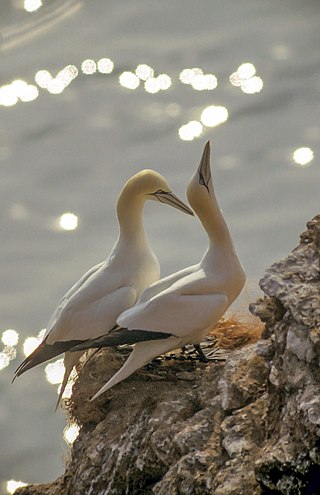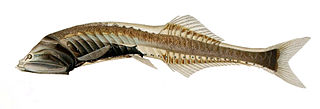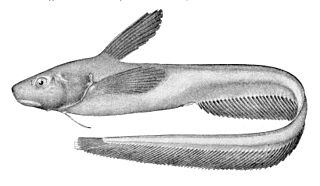
Puffins are any of three species of small alcids (auks) in the bird genus Fratercula. These are pelagic seabirds that feed primarily by diving in the water. They breed in large colonies on coastal cliffs or offshore islands, nesting in crevices among rocks or in burrows in the soil. Two species, the tufted puffin and horned puffin, are found in the North Pacific Ocean, while the Atlantic puffin is found in the North Atlantic Ocean.

The Anatidae are the biological family of water birds that includes ducks, geese, and swans. The family has a cosmopolitan distribution, occurring on all the world's continents except Antarctica. These birds are adapted for swimming, floating on the water surface, and, in some cases, diving in at least shallow water. The family contains around 174 species in 43 genera.

Gannets are seabirds comprising the genus Morus in the family Sulidae, closely related to boobies. They are known as 'solan' or 'solan goose' in Scotland. A common misconception is that the Scottish name is 'guga' but this is the Gaelic name referring to the chicks only.

The family Proteidae is a group of aquatic salamanders found today in the Balkan Peninsula and North America. The range of the genus Necturus runs from southern central Canada, through the midwestern United States, east to North Carolina and south to Georgia and Mississippi. The range of the olm, the only extant member of the genus Proteus, is limited to the Western Balkans. The fossil record of the family extends back to the Late Cretaceous, with Paranecturus being known from the Maastrichtian of North America, and Bishara from the Santonian-Campanian of Central Asia.

Arctostaphylos is a genus of plants comprising the manzanitas and bearberries. There are about 60 species of Arctostaphylos, ranging from ground-hugging arctic, coastal, and mountain shrub to small trees up to 6 m (20 ft) tall. Most are evergreen, with small oval leaves 1–7 cm (0.4–3 in) long, arranged spirally on the stems. The flowers are bell-shaped, white or pale pink, and borne in small clusters of 2–20 together; flowering is in the spring. The fruit are small berries, ripening in the summer or autumn. The berries of some species are edible.

The Molidae comprise the family of the molas or ocean sunfishes, unusual fish whose bodies come to an end just behind the dorsal and anal fins, giving them a "half-fish" appearance. They are also the largest of the ray-finned bony fish, with the southern sunfish, Mola alexandrini, recorded at 4.6 m (15 ft) in length and 2,744 kg (6,049 lb) in weight.
Kentriodon is an extinct genus of toothed whale related to modern-day dolphins. Fossils have been found in North America, Europe and Japan. Several species have been described.

Carcharias is a genus of mackerel sharks belonging to the family Odontaspididae. Once bearing many prehistoric species, all have gone extinct with the exception of the critically endangered sand tiger shark.

The Chimaeridae, or short-nosed chimaeras, are a family of cartilaginous fish.

Scomber is a genus of ray-finned fish in the family Scombridae living in the open ocean found in Atlantic, Indian and Pacific Ocean. The genus Scomber and the genus Rastrelliger comprise the tribe Scombrini, known as the "true mackerels". These fishes have an elongated body, highly streamlined, muscular and agile. The eyes are large, the head is elongated, with a big mouth provided with teeth. They have two triangular dorsal fins, with some stabilizing fins along the caudal peduncle. The basic color is blue-green with a silvery white belly and a darker back, usually black mottled.

Chimaera is the type genus of the cartilaginous fish family Chimaeridae.

Cyclothone is a genus containing 13 extant species of bioluminescent fish, commonly known as 'bristlemouths' or 'bristlefishes' due to their shared characteristic of sharp, bristle-like teeth. These fishes typically grow to around 1–3 inches, though some can be larger. They are most commonly found in the mesopelagic zone of the ocean, mostly at depths of over 300 meters, and many species have bioluminescence.
Neoconger is a genus of eels of marine ray-finned fishes belonging to the family Moringuidae, the spaghetti eels. These eels occur in shallow tropical and subtropical waters.

Drombus is a genus of gobies native to fresh, brackish and marine waters of the Indian Ocean and the western Pacific Ocean.

Caulolatilus is a genus of tilefishes native to the Pacific and Atlantic coasts of the Americas. This genus is regarded as the least specialised and the most basal of the tilefishes.

Ijimaia plicatellus is a species of jellynose fish in the family Ateleopodidae. Their distribution is in the Eastern Central Pacific near Hawaii, at depths from 265 to 500 meters. The species can reach up to 68 centimeters in length.
Brockius is a genus of labrisomid blennies from the waters of the eastern Pacific and the western Atlantic where they are associated with reefs and seaweed-covered rocks.
Ijimaia dofleini, often called the Ô-shachiburi in Japanese, is a species of ray-finned fish within the family Ateleopodidae. The species is known from four localities in the Pacific Ocean. These localities were in marine waters of the Sagami Sea, Ryuku Islands, Taiwan, and Society Islands at depths of 300 to 500 meters, living near benthopelagic environments on outer continental shelfs and slopes. The species can grow up to lengths of 124 to 170 centimeters. It has been assessed as 'Data deficient' by the IUCN Red List in 2018 due to there being limited information on its distribution, population, and ecology.
Ijimaia antillarum is a species of ray-finned fish within the family Ateleopodidae. The species has a range off of parts of North and South America in the Atlantic, spanning from New England states to Suriname and Santa Catarina to Tramandai in Brazil off continental slopes, inhabiting benthopelagic environments 320 to 732 meters below sea level. Lengths of the species range from 85.5 to 165 centimeters. The species has been assessed as 'Least concern' in 2019 by the IUCN Red List due to its large range and lack of any known major threats.














